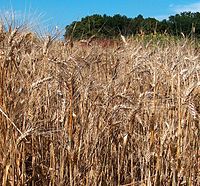
Photo from wikipedia
Abstract Fusarium head blight (FHB) is a global wheat disease that devastates wheat production. Resistance to FHB spread within a wheat spike (type II resistance) and to mycotoxin accumulation in… Click to show full abstract
Abstract Fusarium head blight (FHB) is a global wheat disease that devastates wheat production. Resistance to FHB spread within a wheat spike (type II resistance) and to mycotoxin accumulation in infected kernel (type III resistance) are the two main types of resistance. Of hundreds of QTL that have been reported, only a few can be used in wheat breeding because most show minor and/or inconsistent effects in different genetic backgrounds. We describe a new strategy for identifying robust and reliable meta-QTL (mQTL) that can be used for improvement of wheat FHB resistance. It involves integration of mQTL analysis with mQTL physical mapping and identification of single-copy markers and candidate genes. Using meta-analysis, we consolidated 625 original QTL from 113 publications into 118 genetic map-based mQTL (gmQTL). These gmQTL were further located on the Chinese Spring reference sequence map. Finally, 77 high-confidence mQTL (hcmQTL) were selected from the reference sequence-based mQTL (smQTL). Locus-specific single nucleotide polymorphism (SNP) and simple sequence repeat (SSR) markers and 17 genes responsive to FHB were then identified in the hcmQTL intervals by combined analysis of transcriptomic and proteomic data. This work may lead to a comprehensive molecular breeding platform for improving wheat resistance to FHB.
Journal Title: Crop Journal
Year Published: 2020
Link to full text (if available)
Share on Social Media: Sign Up to like & get
recommendations!